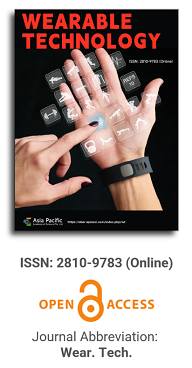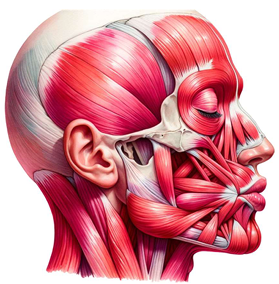

This paper delves deeply into the innovative realm of integrating human emotions with wearable technology. The primary focus is on the conceptualization and development of a kiss transfer device that harnesses the power of wearable technology to bridge the physical gap in human-human interactions. By investigating the intricate nuances of the human-human kissing process, the research seeks to replicate this intimate gesture through a technological medium. The paper not only elaborates on the anatomy, evolution, and hormonal dynamics of kissing but also underscores the transformative potential of wearable technology in capturing and transmitting these intimate moments. This exploration opens up new horizons for long-distance relationships, offering a tangible touchpoint that goes beyond traditional communication methods. Through this pioneering work, the research positions wearable technology as not just a tool for communication but as an extension of our human emotions and expressions.

Research progress of wearable plantar pressure monitoring system
Vol 3, Issue 1, 2022
Download PDF
Abstract
Keywords
References
- Dong X, Fan Y, Zhang M, et al. Studies on biomechanics of human foot. Journal of Biomedical Engineering 2002; 19( 1): 148–153.
- Pataky TC, Mu T, Bosch K, et al. Gait recognition: highly unique dynamic plantar pressure patterns among 104 individuals. Journal of the Royal Society Interface 2011; 9(69): 790–800.
- Guo X. Characteristics of foot shape and plantar pressure change and recovery of long-distance runners [Master’s thesis]. Beijing: Beijing Sport University; 2019. p. 41–7.
- Namika M, Koutatsu N, Keiichi T, et al. Plantar pressure distribution during standing in women with end stage hip osteoarthritis. Gait & Posture 2020; 76: 39–43.
- Gefen A, Ravid M, Itzchak Y, et al. Biomechanical analysis of the three-dimensional foot structure during gait: A basic tool for clinical applications. Biomedicine Engineering 2000; 12(2): 621–630.
- Enrique MO, Ricardo BBV, Marta LI, et al. Foot internal stress distribution during impact in barefoot running as function of the strike pattern. Computer Methods in Biomechanics and Biomedical Engineering 2018; 21(7): 471–478.
- Yam CY, Nixon MS, Carter JN. Automated person recognition by walking and running via model-based approaches. Pattern Recognition 2004; 37(5): 1057–1072.
- Jin M. A sensing insole for measuring plantar pressure distribution [Master’s thesis]. Shanghai: Donghua University; 2010. p. 11–2.
- Wunderlich RE, Ichmond BG, Hatala KG, et al. The relationship between plantar pressure and footprint shape. Journal of Human Evolution 2013; 65(1): 21–28.
- Dong K, Peng X, An J, et al. Shape adaptable and highly resilient 3D braided triboelectric nanogenerators as e-textiles for power and sensing. Nature Communications 2020; 11(1): 1–11.
- Zhai Y, Shen L. Research and prospect of conductive textiles. Cotton Textile Technology 2019; 47(2): 81–84.
- Le P, Wang S, Li X, et al. Preparation of polyaniline/Ag composite conductive fabric via one-step oxidation-reduction reaction. Journal of Textile Research 2014; 35(4): 37–42.
- Qiu S, Su X, Jia Y, et al. Preparation and property of polyester conductive fiber. Applied Chemical Industry 2017; 46(2): 325–327.
- Li S, Wu G, Hu Y, et al. Preparation of pressure distribution monitoring socks and related sensing properties. Journal of Textile Research 2019; 40(7): 138–144.
- Guignier C, Camillieri B, Schmid M, et al. E-knitted textile with polymer optical fibers for friction and pressure monitoring in socks. Sensors 2019; 19(13): 3011.
- Xiong Y, Tao X. Research progress of smart sensing textiles. Knitting Industries; 2019(7): 8–12.
- Zhang H. Flexible textile-based strain sensor induced by contacts. Measurement Science and Technology 2015; 26(10): 105102.
- Takamatsu S, Kobayashi T, Shibayama N, et al. Fabric pressure sensor array fabricated with diecoating and weaving techniques. Sensors and Actuators A: Physical 2012; 184: 57–63.
- Li L, Zhao W. Plantar pressure measurement system based on PVDF piezoelectric sensor. Transducer and Microsystem Technologies 2018; 37(5): 73–75,79.
- Wen G. Research on wearable dynamic measurement system of plantar pressure [Master’s thesis]. Luoyang: Henan University of Science and Technology; 2019. p. 23–5.
- Wang H, Lang R, Wang F, et al. Prediction model and analysis of foot-ground reaction force based on pressure insole. Journal of Textile Research 2019; 40(11): 175–181.
- Song G, Song Z, Xiang Z. Gait phase recognition under proportion-uncontrolled body weight support based on plantar pressure sensor. Chinese Journal of Engineering Design 2019; 26(3): 260–266.
- Lee SJ, Jeong DW, Kim DE, et al. Effect of taping therapy and inner arch support on plantar lower body alignment and gait. Korean Journal of Sport Biomechanics 2017; 27(3): 229–238.
- Lin F, Li Yan, Song W. Selection of wearable smart insoles foot pressure collection points: A review. Chinese Journal of Ergonomics 2019; 25(2): 6–13.
- He J, Hu C, Wang X. A smart device enabled system for autonomous fall detection and alert. International Journal of Distributed Sensor Networks 2016; 12(2): 2308183.
- Momose Y, Suenaga T. Gender differences in the occurrence of nonfatal agricultural injuries among farmers in fukuoka. Jpn J Rural Med 2015; 10: 57–64.
- Kim I, Lee K, Kim K, et al. Implementation of a real-time fall detection system for elderly Korean farmers using an insole-integrated sensing device. Instrumentation Science & Technology 2019; 48(1): 22–42.
- Hong X, Chen X, Chu J, et al. Multiple diabetic complications, as well as impaired physical and mental function, are associated with declining balance function in older persons with diabetes mellitus. Clin Interv Aging 2017; 12:189–195.
- Patry J, Belley R, Côté M, et al. Plantar pressures, plantar forces, and their influence on the pathogenesis of diabetic foot ulcers: a review. Journal of the American Podiatric Medical Association 2013; 103(4): 322–323.
- Bu Y, Wang F, Zhang J, et al. Plantar pressure and gait characteristics in older adult patients with diabetes. Chinese Journal of Tissue Engineering Research 2020; 24(5): 736–740.
- Fu X, Xie C, Jiang Y, et al. Decompression treatment for diabetic patients with abnormal plantar foot pressure: effect evaluation. Journal of Nursing Science 2014; 20(5): 14–16.
- Dawson MR. Gait recognition R. London: Imperial College of Science, Technology & Medicine, 2002.
- Lv J, Nie Z, Zhang Y, et al. Plantar feature region division based on biomechanical data. Chinese Journal of Tissue Engineering Research 2020; 24(36): 5774–5778.
- Zhang W, Yao L, Ji R. Application of bayesian discriminant method to individual recognition based on foot pressure characteristics. Journal of People’s Public Security University of China (Science and Technology) 2017; 23(4): 18–3.
- Chen Huan. Study on the feasibility of foot orthosis in the treatment of foot pain in pregnant women. Chinese Journal of Rehabilitation 2019; 34(1): 46–49.
- Wang X, Yan S, Zheng H, et al. Characteristics of dynamic plantar pressure during walking in children with spastic cerebral palsy. Beijing Biomedical Engineering 2019; 38(1): 28–35.
- Braun BJ, Bushuven E, Hell R, et al. A novel tool for continuous fracture aftercare-clinical feasibility and first results of a new telemetric gait analysis insole. Injury 2016; 47(2): 490–494.
- Chen X. Research on flexible tactile sensor for prosthesis hand [PhD thesis]. Hangzhou: Zhejiang University; 2016. p. 84–90.
Supporting Agencies
Copyright (c) 2022 Zujiao Chen, Rui Zhang, Wenwen Zhuo, Longlin Zhang, Li Zhou

This work is licensed under a Creative Commons Attribution 4.0 International License.

Prof. Zhen Cao
College of Information Science & Electronic Engineering, Zhejiang University
China, China
Processing Speed
-
-
-
- <5 days from submission to initial review decision;
- 62% acceptance rate
-
-
Asia Pacific Academy of Science Pte. Ltd. (APACSCI) specializes in international journal publishing. APACSCI adopts the open access publishing model and provides an important communication bridge for academic groups whose interest fields include engineering, technology, medicine, computer, mathematics, agriculture and forestry, and environment.





